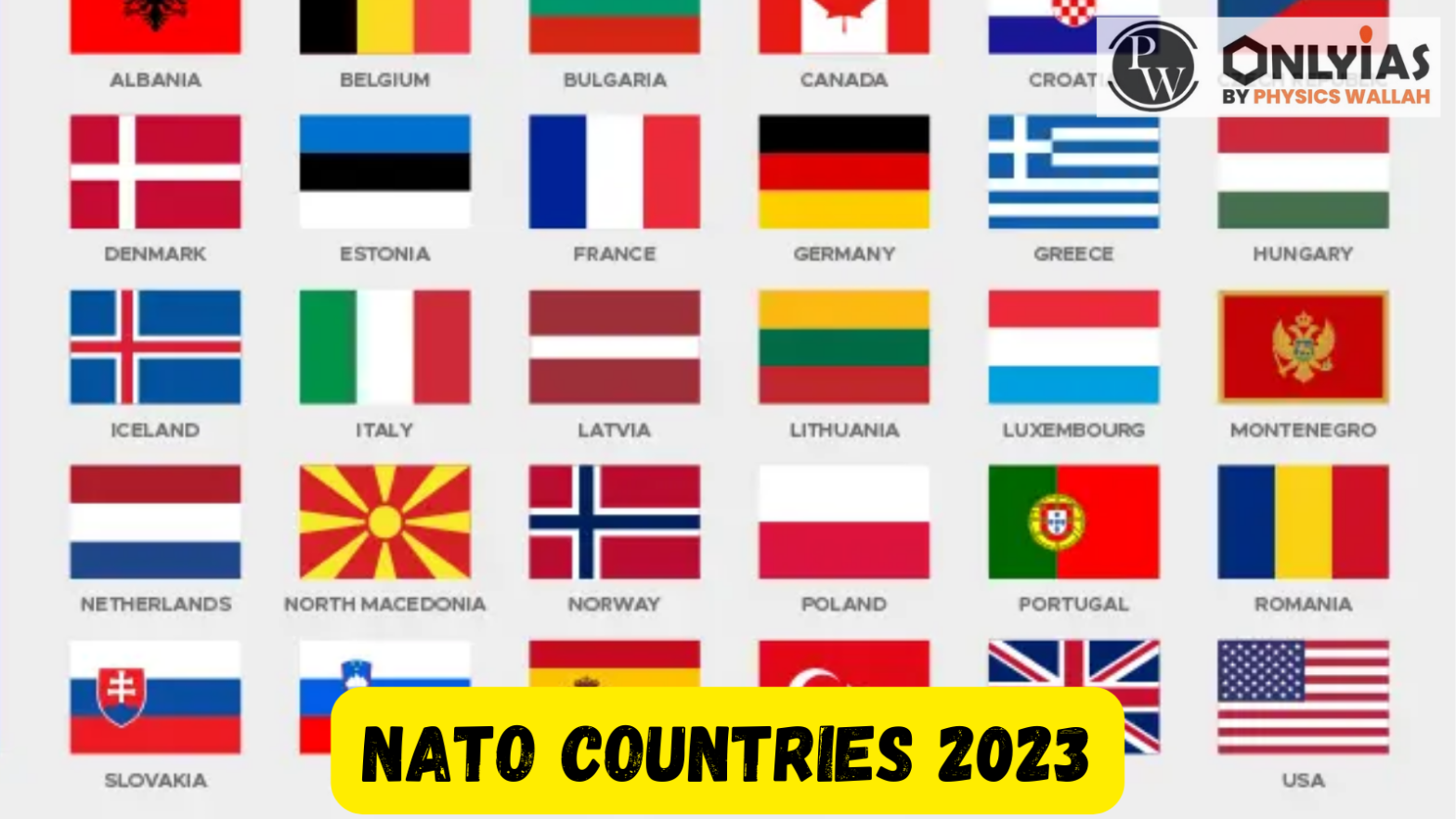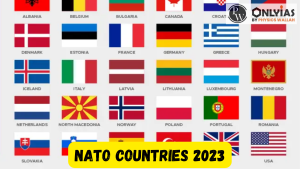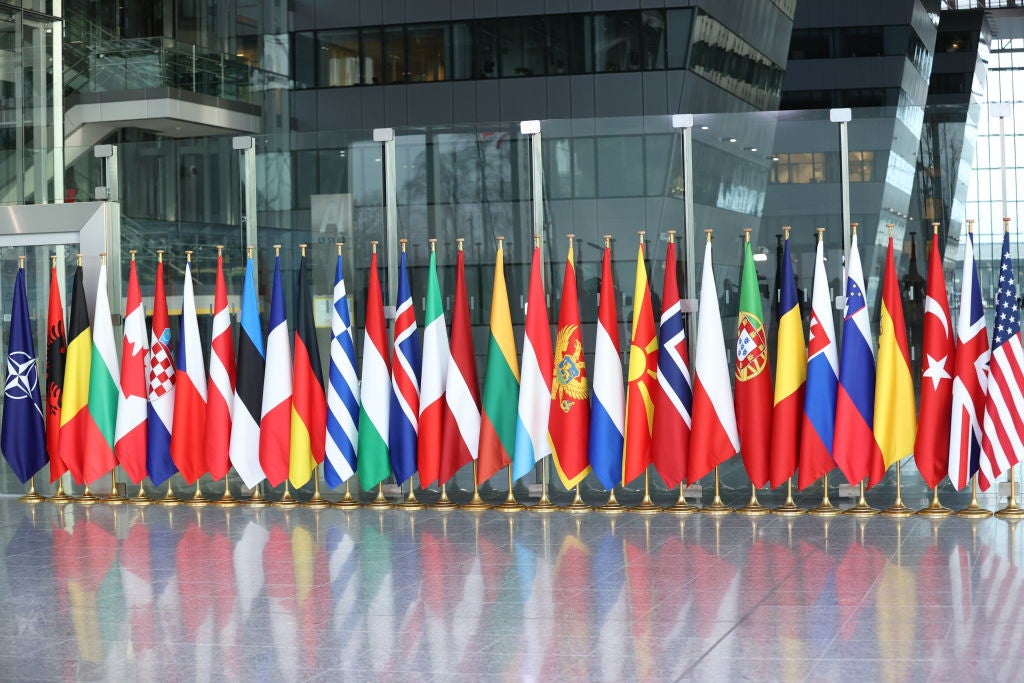Explore the 30 member countries of NATO (2023) and their significance for UPSC exams.

NATO, or the North Atlantic Treaty Organization, is a military alliance of countries dedicated to mutual defense and security cooperation.
The North Atlantic Treaty Organization (NATO) stands as one of the most prominent international alliances, serving as a cornerstone of collective defense and security cooperation among member nations. As of 2023, NATO comprises a diverse group of countries, each contributing to the alliance’s shared goals. In this article, we delve into the list of NATO member countries for 2023, explore their geographical representation on the map, understand the organization’s full form, and familiarize ourselves with the names of the member nations.

NATO was established in 1949 with the signing of the North Atlantic Treaty, aiming to create a defensive alliance against potential aggressors and promote stability in the North Atlantic region. Over the years, NATO’s scope and objectives have evolved, encompassing a wide range of security issues and cooperation endeavors.
NATO’s role as a guardian of collective security remains unwavering. It is a conduit that spans the Atlantic, bridging the realms of North America and Europe in an unbreakable commitment to safeguarding their shared democratic values. The alliance serves as a tangible embodiment of the enduring ties that unite these regions, solidifying their intertwined destinies.
The expansion of NATO’s membership has propelled the realization of a vision rooted in unity, freedom, and lasting tranquility. As the number of member nations has grown, the organization’s impact has extended further, aligning with the United States’ aspiration for a Europe characterized by unity, freedom, and harmonious coexistence.
NATO’s acronym stands for the North Atlantic Treaty Organization. This name aptly reflects the organization’s origins and its core mission of ensuring security and cooperation among nations bordering the North Atlantic Ocean. NATO serves as a forum for member countries to consult and collaborate on security-related matters, emphasizing the values of democracy, individual liberty, and the rule of law.
As of 2023, NATO consists of 30 member countries, spanning across North America and Europe. These nations have come together to forge a collective commitment to mutual defense and security, fostering cooperation in military, political, and strategic realms.

The member countries of NATO in 2023 include:
NATO countries 2023 |
|
|---|---|
| NATO Country | Capital City |
| Albania | Tirana |
| Belgium | Brussels |
| Bulgaria | Sofia |
| Canada | Ottawa |
| Croatia | Zagreb |
| Czechia | Prague |
| Denmark | Copenhagen |
| Estonia | Tallinn |
| Finland (2023) | Helsinki |
| France | Paris |
| Germany (1955) | Berlin |
| Greece (1952) | Athens |
| Hungary (1999) | Budapest |
| Iceland | Reykjavík |
| Italy | Rome |
| Latvia | Riga |
| Lithuania | Vilnius |
| Luxembourg | Luxembourg |
| Montenegro (2017) | Podgorica |
| Netherlands | Amsterdam |
| North Macedonia (2020) | Skopje |
| Norway | Oslo |
| Poland (1999) | Warsaw |
| Portugal | Lisbon |
| Romania (2004) | Bucharest |
| Slovakia (2004) | Bratislava |
| Slovenia (2004) | Ljubljana |
| Spain (1982) | Madrid |
| The United Kingdom | London |
| The United States | Washington, D.C. |
| Türkiye (1952) | Ankara |
The member countries of NATO are strategically positioned across North America and Europe, forming a transatlantic alliance that contributes to the security and stability of the region. While North American nations such as the United States and Canada play a crucial role, European countries also actively participate in collective defense efforts.
To enhance comprehension, refer to the NATO Countries Map provided here:

The NATO member countries represent a diverse array of cultures, histories, and geopolitical landscapes. From the bustling cities of North America to the historic sites of Europe, each nation brings unique strengths and contributions to the alliance. The collective defense framework underscores the principle that an attack on one member is considered an attack on all, fostering a sense of unity and shared responsibility.
In conclusion, the NATO alliance continues to play a pivotal role in shaping the global security landscape. The member countries of NATO, spanning across North America and Europe, stand united in their commitment to safeguarding peace, promoting stability, and fostering international cooperation. As the geopolitical dynamics evolve, NATO remains a cornerstone of collective defense and a testament to the enduring strength of international partnerships.
States and Capitals of India 2023, List of 28 Indian States and 8 Union Territories 2023
The original 12 founding members of NATO include the United States, the United Kingdom, Belgium, Canada, Denmark, France, Iceland, Italy, Luxembourg, the Netherlands, Norway, and Portugal.
NATO serves distinct purposes and objectives across both political and military spheres.
One of NATO’s primary functions is to promote democratic values and facilitate collaboration among its member countries on matters concerning defense and security. This cooperation is geared towards resolving disputes, cultivating mutual trust, and ultimately reducing the likelihood of conflicts.
NATO emphasizes the resolution of conflicts through peaceful means. In situations where diplomatic efforts prove insufficient, the organization possesses the military capability to engage in crisis-management operations. These actions may be conducted independently or in partnership with other nations and international entities, often in alignment with a United Nations mandate or the collective defense provision outlined in Article 5 of the Washington Treaty.
NATO is firmly committed to the principle that an attack on any member nation is deemed an attack on all members collectively. This principle of collective defense is enshrined in Article 5 of the Washington Treaty. Notably, Article 5 was invoked only once, in response to the 9/11 terrorist attacks on the United States in 2001.
NATO’s composition encompasses countries from both North America and Europe, establishing a unique transatlantic bond. This connection facilitates consultations, collaborative efforts on security and defense issues, and the coordination of international crisis management endeavors.
Finland has recently joined NATO as its 31st member, signifying a significant shift in the security dynamics of northeastern Europe.
With an extensive 832-mile border with Russia, Finland’s inclusion in NATO bolsters security, doubling the protection along its border.
Impact on Russia: Russia may perceive NATO’s expansion as a challenge to its sphere of influence, potentially straining relations with the West, heightening regional tensions, and introducing new geopolitical fault lines.
Alteration of Power Dynamics: Finland’s NATO membership could augment the alliance’s position in the Baltic Sea region, potentially reshaping the power balance vis-à-vis Russia.
Finland’s NATO affiliation contributes genuine military capability to the Western alliance in the Nordic region. This could impact the geopolitics and economic desirability of the Arctic, posing challenges for global governance in the area. India, as an observer of the Arctic Council, seeks to foster comprehensive cooperation in the polar north.
Strengthened Security for Finland: Given Finland’s extensive 832-mile border with Russia, its alignment with NATO would substantially fortify its security measures. This integration into NATO would not only double the length of the alliance’s border with Russia but also enhance border security significantly.
Russia’s Perspective: The expansion of NATO could be perceived by Russia as encroaching upon its sphere of influence. This potential perception might contribute to a further deterioration of relations between Russia and Western nations, intensifying regional tensions and potentially establishing new geopolitical fault lines.
Altering the Power Dynamics: Finland’s accession to NATO holds the potential to bolster the alliance’s positioning in the Baltic Sea region, potentially reconfiguring the equilibrium of power concerning Russia.
Influence on Arctic Geopolitics: The inclusion of Finland within NATO adds tangible military capabilities to the alliance’s presence in the Nordic region. This infusion of military strength could potentially impact the geopolitical landscape of the Arctic region, affecting its commercial allure and subsequently posing challenges to global governance in the Arctic. Worth noting is India’s status as an observer of the Arctic Council, with a commitment to fostering comprehensive cooperation in the polar north.
In response to NATO’s formation, the Soviet Union established its own military coalition known as the Warsaw Pact in 1955. This alliance included seven Eastern European communist states. Following the dissolution of the Soviet Union in 1991, numerous former Warsaw Pact nations sought and gained NATO membership. This cohort encompasses countries like Hungary, Poland, Bulgaria, Estonia, Latvia, and others. Notably, recent additions to NATO include North Macedonia in 2020 and Finland in 2023, culminating in a total of 31 member states.
Major Non-NATO Ally Status denotes a designation bestowed by the US government upon close allies with strategic collaboration ties to the US Armed Forces. While these allies are not official NATO members, they enjoy various military and financial privileges. These advantages encompass participation in defense research initiatives, counter-terrorism endeavors, and access to specific military resources like depleted uranium ammunition. Among the 30 countries recognized with this status are Japan, South Korea, and Israel.
Fundamental Conditions for NATO Membership, Article 10 of the North Atlantic Treaty outlines the prerequisites for aspiring NATO member states as follows:
Commitment to Democracy: Prospective members must uphold democratic principles and demonstrate a willingness to tolerate diversity.
Progress towards Market Economy: Aspiring members should exhibit progress in transitioning to a market-oriented economy.
Civilian Control over Military Forces: The military forces of prospective members must remain under robust civilian control.
Respect for Neighbors’ Sovereignty: A key criterion involves maintaining respectful relationships with neighboring countries and upholding sovereignty beyond one’s borders.
Compatibility with NATO Forces: Aspiring members should strive towards compatibility with NATO’s military forces.
Gaining NATO membership entails a rigorous and lengthy process, culminating in unanimous approval from all 31 existing allied nations.
Enhanced Security: NATO membership affords access to a collective defense mechanism, acting as a deterrent against potential threats and safeguarding member countries from acts of aggression.
Augmented Military Capacities: Membership offers access to advanced military technologies, training programs, and collaborative exercises with other NATO nations, elevating a country’s military capabilities and preparedness.
Political Influence: Being a NATO member amplifies a nation’s international influence, granting it a more influential voice on the global stage and an increased role in shaping worldwide security and defense affairs.

<div class="new-fform">
</div>